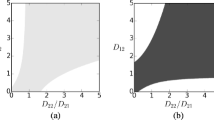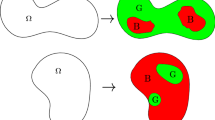Abstract
Stochastic reaction-diffusion equations are a popular modelling approach for studying interacting populations in a heterogeneous environment under the influence of environmental fluctuations. Although the theoretical basis of alternative models such as Fokker-Planck diffusion is not less convincing, movement of populations is most commonly modelled using the diffusion law due to Fick. An interesting feature of Fokker-Planck diffusion is the fact that for spatially varying diffusion coefficients the stationary solution is not a homogeneous distribution – in contrast to Fick’s law of diffusion. Instead, concentration accumulates in regions of low diffusivity and tends to lower levels for areas of high diffusivity. Thus, we may interpret the stationary distribution of the Fokker-Planck diffusion as a reflection of different levels of habitat quality. Moreover, the most common model for environmental fluctuations, linear multiplicative noise, is based on the assumption that individuals respond independently to stochastic environmental fluctuations. For large population densities the assumption of independence is debatable and the model further implies that noise intensities can increase to arbitrarily high levels. Therefore, instead of the commonly used linear multiplicative noise model, we implement environmental variability by an alternative nonlinear noise term which never exceeds a certain maximum noise intensity. With Fokker-Planck diffusion and the nonlinear noise model replacing the classical approaches we investigate a simple invasive system based on the Lotka-Volterra competition model. We observe that the heterogeneous stationary distribution generated by Fokker-Planck diffusion generally facilitates the formation of segregated habitats of resident and invader. However, this segregation can be broken by nonlinear noise leading to coexistence of resident and invader across the whole spatial domain, an effect that would not be possible in the non-spatial version of the competition model for the parameters considered here.
Similar content being viewed by others
References
M. Bengfort, U. Feudel, F.M. Hilker, H. Malchow, Plankton blooms and patchiness generated by heterogeneous physical environments, Ecological Complexity 20, 185 (2014)
M. Bengfort, H. Malchow, F.M. Hilker, The Fokker-Planck law of diffusion and pattern formation in heterogeneous media, J. Math. Biol. 73, 683 (2016)
M. Bengfort, I. Siekmann, H. Malchow, Invasive competition with fokker-planck diffusion and noise, arXiv:1611.10091v1 [q-bio.PE] (submitted to Ecological Complexity, 2016)
J. Crank, P. Nicolson, A practical method for numerical evaluation of solutions of partial differential equations of the heat-conduction type, Math. Proc. Camb. Phil. Soc. 43, 50 (1947)
W. Ebeling, U. Feudel, Influence of Coulomb interactions on dissipative structures in reaction-diffusion systems, Annalen der Physik (Leipzig) 40, (1983)
U. Feudel, Strukturbildung in Reaktions-Diffusionssystemen mit geladenen Teilchen. Dissertation A, Sektion Physik (Humboldt-Universität Berlin, 1984)
U. Feudel, R. Feistel, W. Ebeling, Electrical dissipative structures in membrane-coupled compartment systems. Annalen der Physik 495, 68 (1984)
A. Fick. U. Diffusion, Annalen der Physik 170, 59 (in German, 1855)
R.A. Fisher, The wave of advance of advantageous genes, Annals of Eugenics 7, 355 (1937)
A.D. Fokker, Die mittlere Energie rotierender elektrischer Dipole im Strahlungsfeld, Annalen der Physik 348, 810 (in German, 1914)
E.A. Fronhofer, T. Hovestadt, H-J. Poethke, From random walks to informed movement, Oikos 122, 857 (2013)
E. Khain, Y.T. Lin, L.M. Sander, Fluctuations and stability in front propagation, Europhys. Lett. 93, 28001 (2011)
P.E. Kloeden, E. Platen, Numerical solution of stochastic differential equations Applications of Mathematics (Springer, Berlin, 1999), Vol. 23
A. Kolmogorov, I. Petrovskii, N. Piskunov, Étude de l’equation de la diffusion avec croissance de la quantité de matière et son application à un problème biologique, Bulletin de l’Université de Moscou, Série Internationale, Section A 1, 1 (1937)
A.N. Kolmogorov, Über die analytischen Methoden in der Wahrscheinlichkeitsrechnung, Math. Ann. 104, 415 (in German, 1931)
H. Malchow, Application of the two-timing method to rapid diffusion problems in nonlinear electrochemical and ecological reaction systems, Syst. Anal. Modelling Simul. 8, 671 (1991)
H. Malchow, U. Feudel, Gleichungen vom Reaktions-Diffusionstyp und einige Beispiele für ihre Bedeutung in der Biologie, Wissenschaftliche Zeitschrift der Humboldt-Universität MNR 35, 458 (1986)
H. Malchow, Zur Theorie dissipativer Strukturbildung unter besonderer Berücksichtigung eindimensional zeitkonstanter Raumstrukturen in nichtlinearen elektrochemischen und ökologischen Reaktions-Diffusionssystemenmit Neumann-Randbedingungen, Dissertation B, Sektion Physik (Humboldt-Universität, Berlin, 1989)
H. Malchow, A. James, R. Brown, Competitive and diffusive invasion in a noisy environment, Math. Med. Biol. 28, 153 (2011)
H. Malchow, S.V. Petrovskii, E. Venturino, Spatiotemporal patterns in ecology and epidemiology: Theory, models, simulations, CRC Mathematical and Computational Biology Series (CRC Press, Boca Raton, 2008)
G.N. Milstein, Numerical integration of stochastic differential equations, Mathematics and Its Applications (Kluwer Academic Publishers, Dordrecht, 1995), Vol. 313
A. Okubo, Diffusion and ecological problems: Mathematical models, Biomathematics Texts (Springer, Berlin, 1980), Vol. 10
A. Okubo, S. Levin, Diffusion and ecological problems: Modern perspectives, Interdisciplinary Applied Mathematics (Springer, New York, 2001), Vol. 14
M. Planck, Über einen Satz der statistischen Dynamik und seine Erweiterung in der Quantentheorie, Sitzungsberichte der Königlich Preussischen Akademie der Wissenschaften XXIV, 324 (in German, 1917)
A. Potapov, U.E. Schlägel, M.A. Lewis, Evolutionarily stable diffusive dispersal, Discrete and Continuous Dyn. Syst. B 19, 3317 (2014)
I. Siekmann, H. Malchow, Fighting enemies and noise: Competition of residents and invaders in a stochastically fluctuating environment, Math. Modelling Nat. Phenom. 11, 120 (2016)
J.G. Skellam, Random dispersal in theoretical populations, Biometrika 38, 196 (1951)
J.G. Skellam, The formulation and interpretation of mathematical models of diffusionary processes in population biology, in The mathematical theory of the dynamics of biological populations, edited by M.S. Bartlett, R.W. Hiorns (Academic Press, New York, 1973), pp. 63–85
A.M. Turing, On the chemical basis of morphogenesis, Phil. Trans. R. Soc. London B 237, 37 (1952)
H. Weissmann, N.M. Shnerb, D.A. Kessler, Theory of pinned fronts, Phys. Rev. E 93, 012405 (2016)
Author information
Authors and Affiliations
Corresponding author
Rights and permissions
About this article
Cite this article
Siekmann, I., Bengfort, M. & Malchow, H. Coexistence of competitors mediated by nonlinear noise. Eur. Phys. J. Spec. Top. 226, 2157–2170 (2017). https://doi.org/10.1140/epjst/e2017-70038-6
Received:
Revised:
Published:
Issue Date:
DOI: https://doi.org/10.1140/epjst/e2017-70038-6




